Home
Travel StoriesBig Trips On A Small Bike
Big Trips On A Small Bike: Part 2
Post Received 16 January 2020, Trip Date 2010
By Mark Noel
From reading my previous account you will realise that I had fallen in love with the little Suzuki GN125 and was ready to embark on a longer adventure after the initial shakedown ride to Mull. As with all big trips, preparation is the key and the first job was first to acquire all mission critical spares. These comprised throttle, clutch and brake cables, a spare ignition module, bulbs and a puncture repair kit. It was 2010 and my 1996 bike still wore the original tyres but these still had plenty of tread and so were left unchanged. I packed all the tools needed to remove wheels and change tyres, plus a decent set of metric spanners, screwdrivers, a pressure gauge, pump, zip ties and gaffer tape. I also made up a chain lube kit using an old shampoo bottle with a brush fitted inside the lid - the bottle was filled with chainsaw oil which is my favourite lubricant having remarkable anti-fling properties.
Now to the bike. The trip to Mull had highlighted the need for some improvements, first to make the journey more comfortable and others to improve the bike still further. I had already fitted lower handlebars to transfer weight away from my back and to improve handling at high Mach numbers. The GN is clearly designed to be a learner-urban commuter and is geared towards this role. Hence, to lower the revs and improve economy I fitted a larger engine sprocket, then partnered this with a sealed O-ring chain dunked in that gloopy chain saw oil. The mudguards were undersealed with bitumen paint, the fork oil drained (by dangling the bike upside down), then re-filled and gaiters fitted.
The five speed gearbox had always befuddled my brain, never quite knowing where I am in a box with close-ish ratios. An electronic gear position indicator from GIpro was installed with a pickup on the rear sprocket and wiring into the coil input. This required careful programming by changing gear through the rev range and eventually gave a reliable indication about 80% of the time - enough to stop me prodding the gear lever in a search for more.
Apart from the lower bars, comfort was improved further by fitting an Airhawk inflatable seat cushion, a wonderful accessory that prevents 'Piles from Miles'. The degree of inflation can be adjusted by unzipping the fleecy cover and blowing into or releasing the valve on the inner bladder. I did this several times on my journey in response to varying road conditions.
Next I sourced a genuine Suzuki luggage rack and welded on brackets to mount the indicators further back so that luggage could dangle down from the seat. The rack was then re-chromed by Castle Chrome, although following that non-ideal experience I now use Perfection Chrome in Hull.
All the steel fastenings were treated with ACF50 and the fitted cables, twistgrip, brake and lever joints lubricated, and absolutely every electrical connection checked for tightness and the potential for wires rubbing on the frame. A sealed battery was fitted.
Obviously when travelling on such a small machine it is essential to minimise the weight and bulk of luggage. At this stage in my adventures I had no panniers, so instead packed a small rucksack and a dry bag with my stuff (including a tent), then stowed camera, maps, passport, currency and wet weather clothing in an Oxford tank back for speedy access. No, I did not have a GPS unit but would rely instead on old-fashioned maps photocopied from an atlas, laminated and held in the clear pocket atop the tank bag.
To my mind it is important to keep a journal recording each day's travel, places and people encountered, together with a fuel and photo log so that mpg can be calculated and an accurate record kept of each picture's location. Yes, it does take some effort to write an account at the end of a day on the road, particularly if you are cold, wet, hungry and stretched out on the lumpy floor of a gloomy tent. However I do find that the very action of committing the record to paper helps to embed these memories into my brain.
So now man and machine were ready to depart, but where should we go? Since my yoof I had seen most of central Europe but big gaps remained to the north and the east. As a geology postgraduate I had also seen a lot of Sweden (and its rocks!) but the Baltic states were then over the horizon with rocks that held no interest. Yes, "that is where we will go" I told the GN which did not flinch at the prospect and so we made a pact to plan our adventure together.
Back in my student days you could reach Norway and Sweden by ferry from Newcastle but now this link has unfortunately closed. I did not fancy riding down to Harwich for a boat to Esjberg which would involve battling busy motorways. Following a tip I discovered that you could hitch a lift aboard a freight ship from Immingham to Brevik in Norway or continue to disembark at Gothenburg. I booked a cabin as one of 12 passengers (the maximum permitted for such vessels) then left the Isle of Man on 17th August 2010 aboard Steam Packet's Mannnan to Liverpool. A leisurely ride on quieter minor roads over the Yorkshire Moors brought us to Immingham port in the evening, after which we had to wait until 3a.m. before me and my fellow passengers were allowed to board.
Although passengers joining freight ships are sometimes seen as a fee-earning inconvenience (understandable), I must say that the accommodation, food and service were exceptional. I wangled a visit to the bridge and to the engine room where a 9 cylinder 2-stroke engine the size of a house was beating away propelling the vessel and its load of containers through the choppy North Sea.
After 36 hours I disembarked in Gothenburg then rode directly east to Stockholm, the capital of Sweden. Enquiries revealed that there was a ferry to Tallin in Estonia, so this was booked for the next day. On a vessel equipped more like a cruise ship, we crossed the Gulf of Bothnia wending our way through countless islands, while being regaled with a stage show, orchestra, shopping and lashings of smorgasbord.
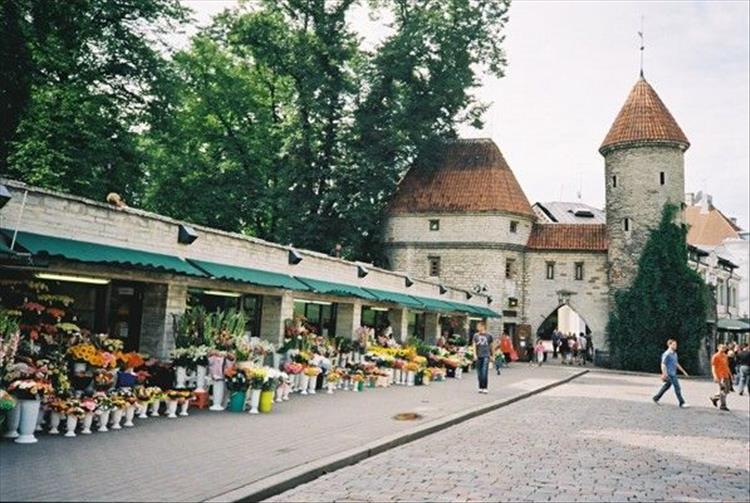
Flower market in Tallin beside the city walls
Berthing in Tallin is like landing in a fantasy mediaeval city - fully restored after the war and bursting with arts, crafts and a wide choice in cafe culture - and where I spent several days re-fueling myself at the start of my Baltic expedition. Now it was time to install the laminated map of Estonia and to head southeast on the E263 towards Tartu, a distance of about 100km. A pleasant surprise was how little traffic there was, which made for much less stress than when riding in England. However the road surfaces on this route were somewhat variable being a mixture of concrete and tarmac, many of which were laid by the Soviets during their occupation of this beautiful country. In many places the effect of heavy trucks rolling over a surface softened by summer heat has been to mould the tar into narrow ridges; one in the centre of the road and two on either side of the carriageway. To keep safe I tended to ride in the centre of my lane, forcing cars to pull out as they approach, upon which I would move towards the kerb, thus maximising clearance with the passing vehicle. Of course being on a microbike almost all vehicles are passing me, rather than me them, and this strategy does mean that you are forced to wobble along the tarmac ridge as the truck or car passes, which can be a bit unnerving.
For anyone who enjoys relaxed riding though dense forests and picturesque villages then this could be the place for you. I wildcamped along the way and restocked my supplies from roadside shops and bakeries. It was interesting to view a country in transition from a Soviet style economy to a more liberated system with rising standards of living but with some downsides too. I passed many abandoned farms which once functioned as collective units but where now the fields were fallow, albeit alive with birds and other wildlife. Unfortunately, the mosquitoes I had met on Mull had joined me on their holidays too!

Wild camping near Smiltene
From Tartu I continued on the E263 to Voru, then turned southwest on to the E77 through Misso before staying at a campsite near Smiltene. The roads and the scenery continued to impress and the next day an easy 60km ride brought me to Riga after crossing the border into Latvia. This brought little change in the riding conditions, with straight roads piercing limitless forest packed with wildlife, the only noticeable thing being a change in road signs and currency. Riga is the capital of Latvia and is more modern and less characterful than Tallin. Here the architecture was more brutal Soviet in style with the high point of my stay being a visit to the Occupation Museum which charted the waves of conquest and invasion suffered by the Latvian people, most recently of course by the Nazis and Russians. It was great wandering through the huge market - to my mind these places represent the heart of any country. But, as with elsewhere in Latvia, I don't think I ever saw someone smile - a grimness that probably reflects their tormented history and the feeling that you are always being watched by a state operative.
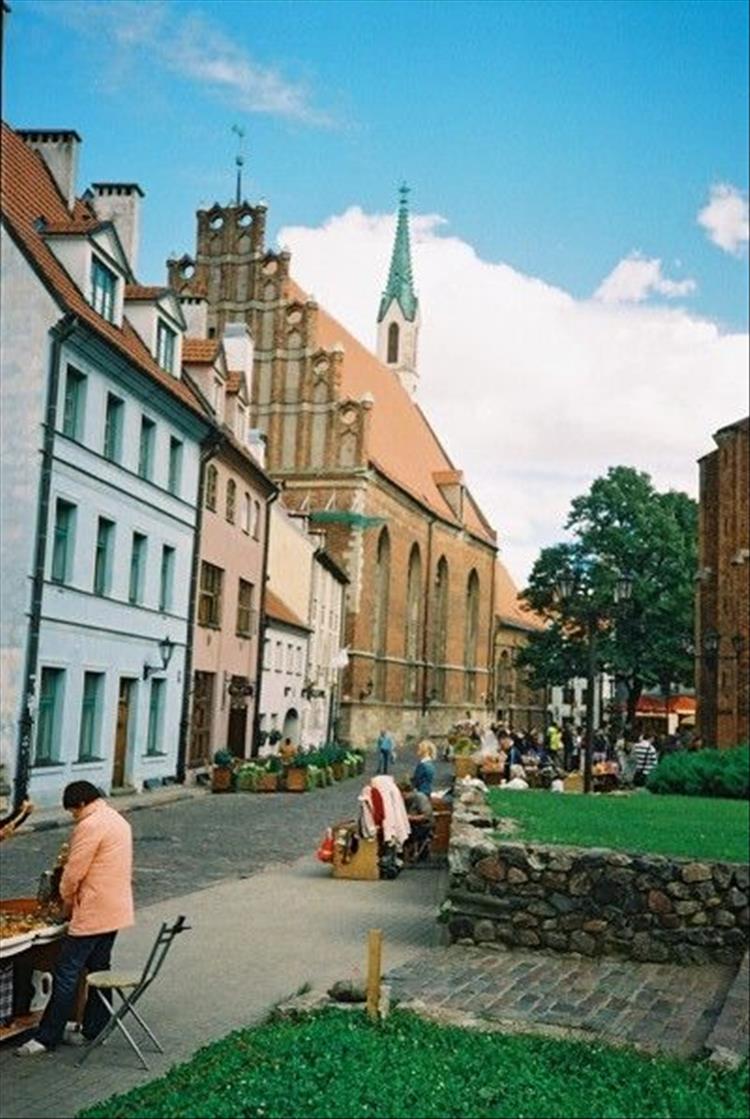
One of the more scenic parts of Riga
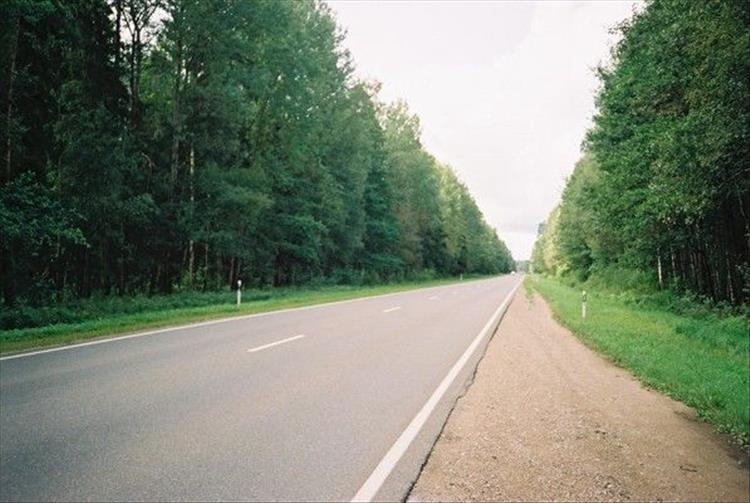
The road to Engure. Try not to fall asleep!

***** Star hotel in Engure
Leaving this humourless metropolis I travelled along the smaller P131 coastal road that borders the Gulf of Riga. This pretty coastal strip is dotted with many picturesque villages, my first stop being at a campsite in Engure. From there I headed North a short distance to the coastal point at Kolka which is a land's end at the boundary between the Gulf of Riga to the East and the open Baltic to the West. Here I noticed something peculiar because the road signs suddenly changed dialect, not to Welsh, but to Livonian since Kolka is part of the Livonian culture with distinct customs and a language drawn from much farther afield.
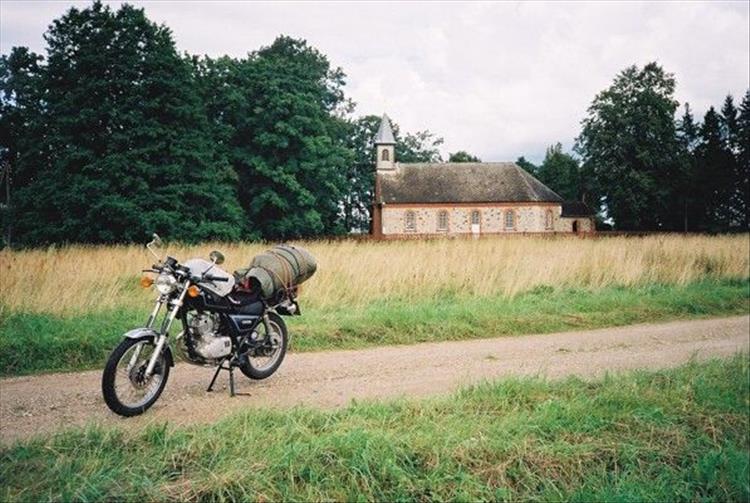
The road near Kolka in the Livonian region
Back aboard the GN we retreated south to Roja then took a minor road West through forest and lakeland scenery to reach a fabulous campsite beside Usmas Ezers (lake). This was a popular retreat for Latvians with lodges, trails and boats that showed another, more prosperous side to the country. Leaving the campsite I spent a day trekking through the forest seeing bear trails and small (less worrying) wildlife along the way.

Hiking a forest trail at Usmas Ezers.
Rejuvenated, we then completed the last 60km leg of my Latvian journey to reach Ventspils, a major port focussed on trade out to Sweden, Poland and other EU countries. This city felt like nowhere else in Latvia, being driven by a visionary mayor to adorn every park and street corner with sculptures, and to create some of the best city parks in Europe. To me the best was The Anchor Park where the trails go past dozens of ships' anchors gathered from all round the world, mounted on plinths with plaques explaining their histories.

One of the many remarkable exhibits in the Ventspils Anchor Park
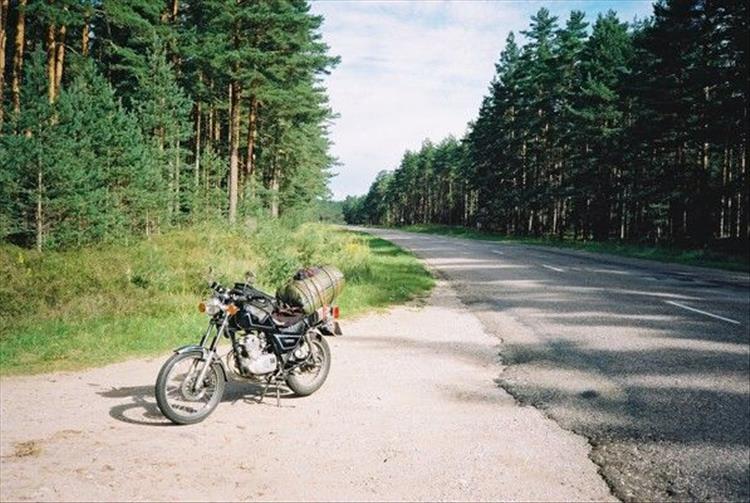
The road south of Ventspils, approaching the Lithuanian border
In Ventspils I found a freight ship bound for Nynasham in Sweden and wasted the day before the sailing by pottering south to the border with Lithuania. On another trip (or life?) I might aim to land in Ventspils and motor on down through this last Baltic State, then tour Poland, taking a boat back to Sweden from Gdansk. The overnight sea crossing to Nynasham was not a luxury cruise but at least brought us back to Sweden and the start of the journey home. The rest was simply a repeat of the journey out: Gothenburg to Immingham, then road and boat back to the Isle of Man. A total of 4 weeks, six ferries, 2100 miles, three oil changes (the sump only holds 850cc), one chain adjustment, no rain and happy memories. Looking back I realise that I encountered not a single UK vehicle on the entire tour despite the delights that these countries have to offer. Sure, these places are not for beach lovers (though Ventspils is), Scandinavia is expensive (but Estonia-Latvia are not) and there are language problems (but not in Sweden). However, if you want the freedom of wild camping and a sense of adventure steeped in nature then what is there not to like?
If you are inspired to explore the Baltic states then I need to draw your attention to the lack of petrol stations even on major highways away from the urban centres. To illustrate this point: I had filled up before Tartu and set the odometer to zero as usual, before heading south. After enjoying the ride for several hours at a sedate 40mph, I realised to my horror that I had passed no filling stations for 150 miles and that emergency measures would be required. I dropped the speed to 30mph, glued my chin to the tank to cut drag and coasted along in fifth gear. After 270 miles I came across a remote fuel station and filled her up with 8 litres. That evening I was astonished to calculate that the GN had achieved 153 miles to the gallon. With this remarkable economy the 10.3 litre tank provides a range of 346 miles. What modern so-called adventure bike can match that? Indeed the GN125 engine is famous for its extreme efficiency having something to do with a 'double squish cylinder head'. In 1981 a faired GN125 with a stock engine set a new record of 215mpg. With that economy you could ride to the moon and back, although I hear that the roads are pretty bad.
Your tale doesn't need to be quite as fantastic as Mark's to share on Bikes And Travels - click here.
Big Trips On A Small Bike: Part 1
Mark has quite an exotic history of powered 2 wheeled velocipedes when a humble 125 crosses his path. Reluctantly he takes it for a little spin to see what it's like.
Big Trips On A Small Bike: Part 2
Mark rather enjoyed his Highland trip on the Suzuki 125, so why not go just a little bit further this time? Maybe dip a toe into Europe?
Big Trips On A Small Bike: Part 3
After a 4 year rest (blimey) Mark decides the GN125 could do with another ride out. But where to go? North. Way North. Way way way North.
Reader's Comments
Ian Soady said :-
An excellent report Mark. I must say I've never had any particular desire to travel to the areas you visited. However, one thing I do regret is not visiting Moscow in the days of the USSR to see the fantastic underground railway syste. Although it is of course still there, I have no desire to visit a country ruled by oligarchs and gangsters.
30/01/2020 10:45:19 UTC
Upt'North said :-
Thanks Mark.
183 mpg, I'd settle for that, but maybe not 30 mph.
Excellent trip report and still an area that I would think is less visited.
Upt'North.
31/01/2020 09:13:50 UTC
Name
Comment
Add a RELEVANT link (not required)
Upload an image (not required) -
Uploading...
Home
Travel StoriesBig Trips On A Small Bike